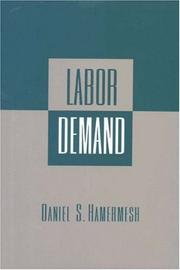| Listing 1 - 4 of 4 |
Sort by
|

ISBN: 0226060837 9786612004759 1282004751 0226060853 9780226060859 9781282004757 6612004754 9780226060835 Year: 2001 Publisher: Chicago London University of Chicago Press
Abstract | Keywords | Export | Availability | Bookmark
 Loading...
Loading...Choose an application
- Reference Manager
- EndNote
- RefWorks (Direct export to RefWorks)
In this timely volume emanating from the National Bureau of Economic Research's program in international economics, leading economists address recent developments in three important areas. The first section of the book focuses on international comparisons of output and prices, and includes papers that present new measures of product market integration, new methodology to infer relative factor price changes from quantitative data, and an ongoing capital stock measurement project. The next section features articles on international trade, including such significant issues as deterring child labor exploitation in developing countries, exchange rate regimes, and mapping U. S. comparative advantage across various factors. The book concludes with research on multinational corporations and includes a discussion of the long-debated issue of whether growth of production abroad substitutes for or is complementary to production growth at home. The papers in the volume are dedicated to Robert E. Lipsey, who for more than a half century at the NBER, contributed significantly to the broad field of empirical international economics.
International economic relations --- International trade --- International economic relations. --- E-books --- international economics, output, prices, exchange rate, developing countries, exploitation, child labor, trade, capital stock measurement, relative factor price, product market integration, multinational corporations, growth, nonfiction, economy, business, capitalism, foreign production, free markets, commerce, industry.
Book
Year: 2008 Publisher: Washington, D.C., The World Bank,
Abstract | Keywords | Export | Availability | Bookmark
 Loading...
Loading...Choose an application
- Reference Manager
- EndNote
- RefWorks (Direct export to RefWorks)
Using firm-level data on manufacturing sectors in Africa, this paper addresses how domestic supply constraints and other firm characteristics explain the geographical orientation of firms' exports and the overall market diversification of African manufacturing exports. The degree of market diversification, measured by the number of export destinations, is highly correlated with export intensity at the firm level, and both embody strong scale effects. Technological factors, such as new vintage capital and Internet access, which improve production efficiency and lower export costs, show strong effects on the firm-level export intensity. Some qualitative differences exist between Africa's regional exports and exports to the global markets. Foreign ownership is a significant factor in characterizing the intensity of global exports but not regional exports. The technological factors are significant in both cases, but more so in global exports. Public infrastructure constraints, such as inferior power services and customs delays, seem to have more immediate impacts on regional exports in general, implying the relevance of addressing behind-the-border constraints in fostering regional integration in Africa. Customs efficiency does matter for textile exports to the global markets, underscoring the importance of improving trade facilitation in Africa for competitive participation of African producers in global supply chain industries.
Commodity prices --- Debt Markets --- Economic Theory and Research --- Export markets --- Factor price --- Finance and Financial Sector Development --- Free Trade --- International Economics & Trade --- International trade --- Macroeconomics and Economic Growth --- Market entry --- Market orientation --- Markets and Market Access --- Microfinance --- Product quality --- Supply chain --- Supply chains --- Total sales
Book
Year: 2008 Publisher: Washington, D.C., The World Bank,
Abstract | Keywords | Export | Availability | Bookmark
 Loading...
Loading...Choose an application
- Reference Manager
- EndNote
- RefWorks (Direct export to RefWorks)
Using firm-level data on manufacturing sectors in Africa, this paper addresses how domestic supply constraints and other firm characteristics explain the geographical orientation of firms' exports and the overall market diversification of African manufacturing exports. The degree of market diversification, measured by the number of export destinations, is highly correlated with export intensity at the firm level, and both embody strong scale effects. Technological factors, such as new vintage capital and Internet access, which improve production efficiency and lower export costs, show strong effects on the firm-level export intensity. Some qualitative differences exist between Africa's regional exports and exports to the global markets. Foreign ownership is a significant factor in characterizing the intensity of global exports but not regional exports. The technological factors are significant in both cases, but more so in global exports. Public infrastructure constraints, such as inferior power services and customs delays, seem to have more immediate impacts on regional exports in general, implying the relevance of addressing behind-the-border constraints in fostering regional integration in Africa. Customs efficiency does matter for textile exports to the global markets, underscoring the importance of improving trade facilitation in Africa for competitive participation of African producers in global supply chain industries.
Commodity prices --- Debt Markets --- Economic Theory and Research --- Export markets --- Factor price --- Finance and Financial Sector Development --- Free Trade --- International Economics & Trade --- International trade --- Macroeconomics and Economic Growth --- Market entry --- Market orientation --- Markets and Market Access --- Microfinance --- Product quality --- Supply chain --- Supply chains --- Total sales

ISBN: 0691025878 0691042543 0691222991 9780691042541 Year: 1996 Publisher: Princeton, New Jersey : University Press,
Abstract | Keywords | Export | Availability | Bookmark
 Loading...
Loading...Choose an application
- Reference Manager
- EndNote
- RefWorks (Direct export to RefWorks)
In this book Daniel Hamermesh provides the first comprehensive picture of the disparate field of labor demand. The author reviews both the static and dynamic theories of labor demand, and provides evaluative summaries of the available empirical research in these two subject areas. Moreover, he uses both theory and evidence to establish a generalized framework for analyzing the impact of policies such as minimum wages, payroll taxes, job- security measures, unemployment insurance, and others. Covering every aspect of labor demand, this book uses material from a wide range of countries.
331.52 --- Labor demand --- Labor market --- Employees --- Market, Labor --- Supply and demand for labor --- Markets --- Demand, Labor --- Demand for labor --- 331.52 Arbeidsmarktstructuur. Vraag en aanbod op de arbeidsmarkt. Spreiding van arbeidsplaatsen. Spreiden van arbeidskrachten. Tewerkstellingsgraad --- Arbeidsmarktstructuur. Vraag en aanbod op de arbeidsmarkt. Spreiding van arbeidsplaatsen. Spreiden van arbeidskrachten. Tewerkstellingsgraad --- Supply and demand --- Labor demand. --- 331.526 --- 331.123 --- Levels of employment. Employment situation, conditions --- #A9402E --- 331.526 Levels of employment. Employment situation, conditions --- 332.630 --- 332.691 --- AA / International- internationaal --- Strijd tegen de werkloosheid: algemeen. Theorie en beleid van de werkgelegenheid. Volledige werkgelegenheid --- Evolutie van de arbeidsmarkt --- Labour market --- Labor market. --- Marché du travail --- Mercado de trabajo. --- Cobb–Douglas production function. --- Comparative advantage. --- Compensating differential. --- Contract curve. --- Cost curve. --- Demand For Labor. --- Demand response. --- Derived demand. --- Developed country. --- Developing country. --- Earnings. --- Economic cost. --- Economic efficiency. --- Economic forces. --- Economic interventionism. --- Economics. --- Efficiency wage. --- Efficiency. --- Elasticity of intertemporal substitution. --- Elasticity of substitution. --- Employment. --- Endogenous growth theory. --- Estimation. --- Excess supply. --- Externality. --- Factor cost. --- Factor price. --- Implicit cost. --- Income elasticity of demand. --- Indifference curve. --- Induced innovation. --- Inelastic. --- Inflation. --- Instrumental variable. --- Investment goods. --- Isoquant. --- Job security. --- John Haltiwanger. --- Labour supply. --- Law of demand. --- Layoff. --- Living wage. --- Long run and short run. --- Mandatory retirement. --- Manufacturing in the United States. --- Marginal cost. --- Marginal product. --- Marginal rate of substitution. --- Marginal rate of technical substitution. --- Maximum wage. --- Minimum wage. --- Monopsony. --- Neoclassical economics. --- Net Change. --- Net investment. --- New Keynesian economics. --- Oligopoly. --- Outsourcing. --- Partial equilibrium. --- Payroll tax. --- Phillips curve. --- Present value. --- Price Change. --- Price elasticity of demand. --- Price elasticity of supply. --- Production function. --- Productive efficiency. --- Productivity. --- Profit (economics). --- Profit maximization. --- Real business-cycle theory. --- Real versus nominal value (economics). --- Real wages. --- Recession. --- Reservation wage. --- Response Lag. --- Risk aversion. --- Scarcity. --- Shephard's lemma. --- Shortage. --- Stephen Nickell. --- Subsidy. --- Substitution effect. --- Supply (economics). --- Supply and demand. --- Supply shock. --- Tax incidence. --- Tax. --- Theory of the firm. --- Time preference. --- Total cost. --- Total factor productivity. --- Trade barrier. --- Unemployment in the United States. --- Unemployment. --- Utility. --- Utilization. --- Variable cost. --- Wage.
| Listing 1 - 4 of 4 |
Sort by
|

 Search
Search Feedback
Feedback About UniCat
About UniCat  Help
Help News
News